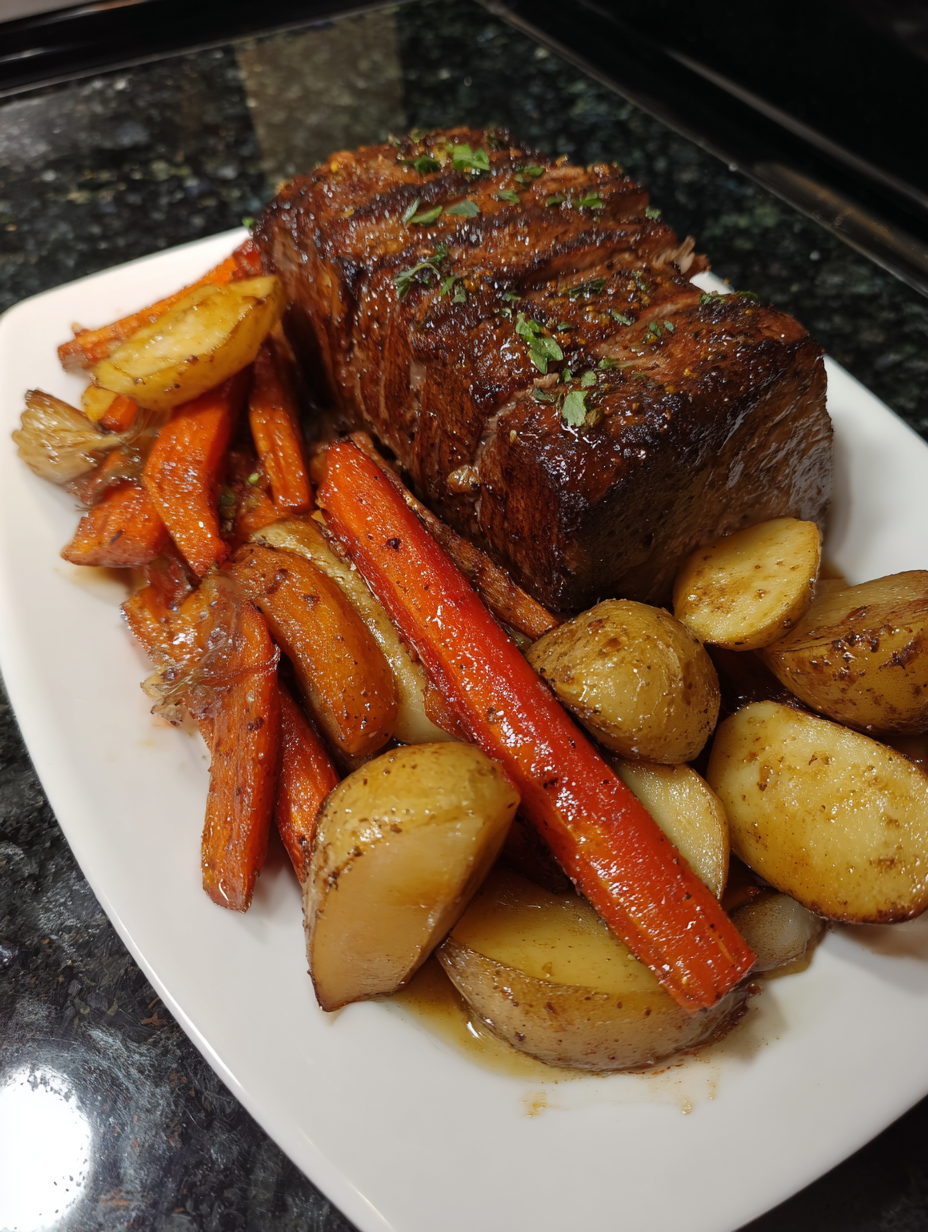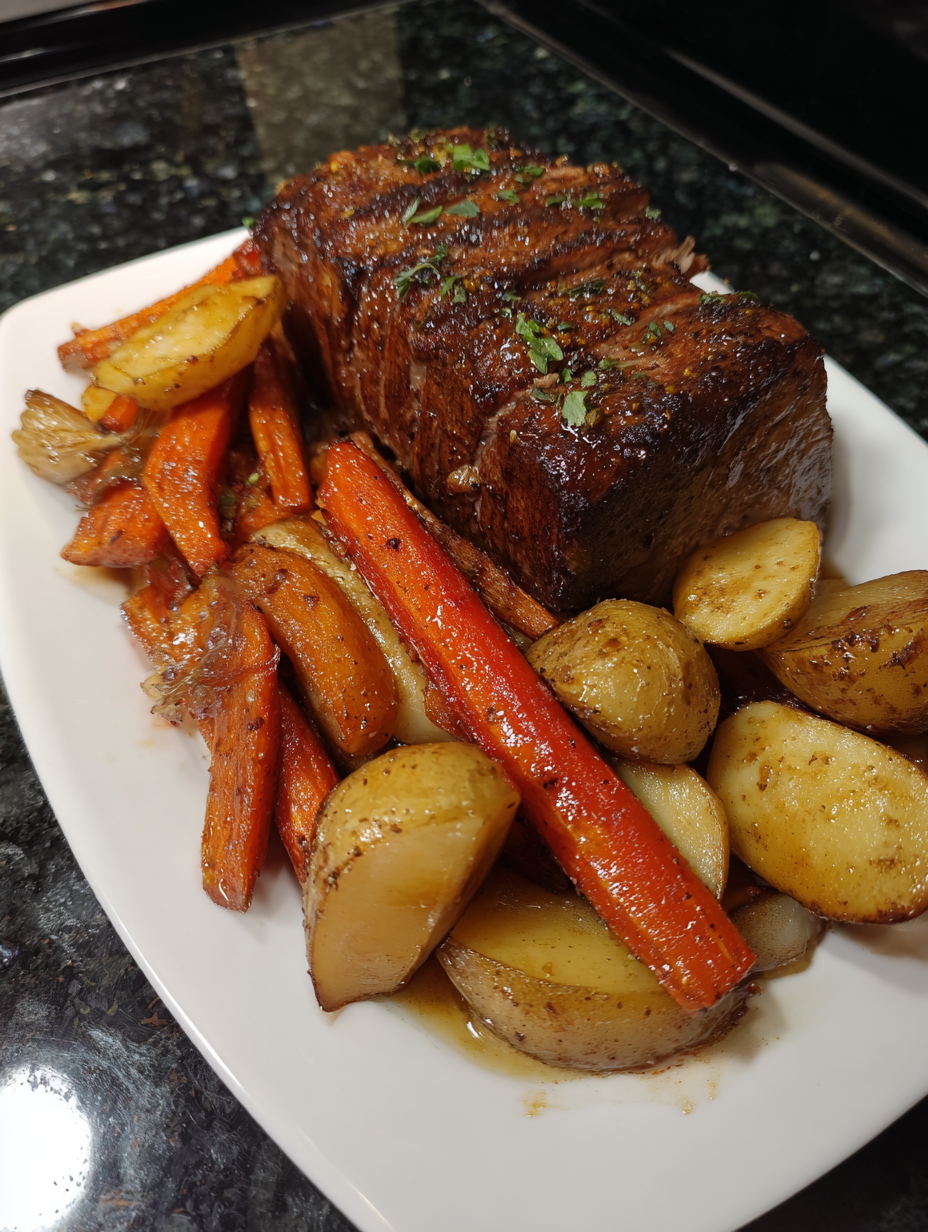 Pin it
Pin it
This Apple Cider Pork Tenderloin fills your kitchen with cozy fall aromas and makes such a satisfying one-pan meal. Tender pork, caramelized apples, and savory roasted vegetables all come together for a showstopper dinner that is both simple and impressive.
I started making this on Sunday afternoons when apples take over the market and my family gathers in the kitchen—now it is requested each time the weather turns cool.
Ingredients
- Pork tenderloin three pounds: Choose evenly sized tenderloins for even cooking and juicy results
- Apple cider two cups: Provides naturally sweet flavor that keeps the pork moist during roasting
- Balsamic vinegar quarter cup: Adds tangy depth and helps tenderize the meat
- Olive oil four tablespoons divided: Use the best quality extra virgin olive oil for richness
- Sea salt one teaspoon divided: Enhances every flavor and helps lock in meat’s juices
- Ground black pepper half teaspoon divided: Choose fresh ground pepper for the most robust taste
- Yukon gold potatoes two pounds: Creamy texture that holds up to roasting Try to pick potatoes that are firm with no blemishes
- Carrots two large: Add natural sweetness and beautiful color to your pan Use fresh, firm carrots
- Honeycrisp or pink lady apples two large: Offer juicy, tart sweetness Look for apples that are crisp for best roasting
- Italian seasoning one teaspoon: Gives herby notes that complement apple and pork
- Butter three tablespoons: Makes your gravy silky and rich Use unsalted to control the salt
- All purpose flour one and a half tablespoons: Helps thicken the gravy to a pourable consistency
Step-by-Step Instructions
- Marinate the Pork:
- Pat the pork tenderloin dry with paper towels. Place pork, apple cider, balsamic vinegar, two tablespoons olive oil, half the salt, and a quarter teaspoon pepper in a large zip-top bag. Let the pork rest in the marinade for at least thirty minutes while you prep the vegetables. This helps flavor and tenderize the meat.
- Prep the Vegetables and Apples:
- While the pork marinates, wash and cut potatoes, carrots, and apples into half-inch pieces. Place the chopped vegetables and apples on a large rimmed baking sheet. Toss evenly with two tablespoons olive oil, Italian seasoning, remaining salt, and black pepper. Spreading into a single layer ensures the best caramelization.
- Roast the Vegetables:
- Place the sheet pan in the oven and roast for twenty five minutes. This gives the vegetables a head start so they become golden and tender.
- Brown the Pork Tenderloin:
- Heat a heavy skillet such as cast iron over medium-high until very hot. Remove pork from marinade and reserve the liquid for gravy. Sear the tenderloins on all sides for about two minutes per side. This gives the pork flavor and color for a beautiful presentation.
- Combine and Roast:
- After vegetables have roasted, use a spatula to toss them and spread into a single layer. Lay the browned pork tenderloin on top and place everything back in the oven. Roast for twenty to twenty five minutes more until the pork’s internal temperature reaches at least one hundred forty five in the thickest part. Use a meat thermometer to check.
- Rest and Prepare Gravy:
- Once roasted, remove pan from the oven. Let pork rest at least ten minutes before slicing to keep all the juices in. While pork rests, place the skillet you browned pork in back over medium heat. Melt butter, then whisk in flour until smooth and starting to bubble. Slowly add the reserved marinade, whisking constantly. Let gravy simmer and reduce for about seven to eight minutes, stirring until glossy and thickened.
- Serve:
- Slice pork and plate with plenty of roasted vegetables and apples. Pour warm gravy over everything and enjoy while hot.
 Pin it
Pin it
My favorite part is always the pan gravy made from the cider marinade. It makes each bite juicy and has become something my kids scoop up with bits of potato, always asking for seconds. There was one autumn when my cousin visited and we finished every drop of gravy at the table—it is that good.
Storage Tips
Store leftovers in an airtight container in the refrigerator for up to three days. The flavors continue to meld and honestly taste even better the next day. To reheat, place slices of pork and vegetables in a covered baking dish and warm in a low oven, adding a splash of water or cider to keep everything from drying out.
Ingredient Substitutions
If you want a slightly sweeter result, swap Yukon gold potatoes for sweet potatoes. Regular apples do work, but I really suggest a crisp, tart variety like Honeycrisp. Gluten free flour can be used in the gravy if needed. For a richer profile, use chicken stock for part of the cider in the marinade.
Serving Suggestions
This pork tenderloin is dinner party worthy with simple sides like crusty bread or a light green salad. The dish also pairs beautifully with sautéed greens or roasted Brussels sprouts for an extra serving of vegetables. Leftovers make terrific sandwiches on toasted rolls with a spoonful of the pan gravy.
Cultural and Seasonal Context
Roasting pork with apples and hearty vegetables is a tradition in many Northern European and American homes when autumn arrives. Apples and cider have long been used to add sweetness and moisture to savory meat dishes. The smell of apples and pork roasting is instantly nostalgic and seasonally festive in my family.
Frequently Asked Questions
- → What's the best way to ensure the pork is cooked perfectly?
Use a meat thermometer! Insert it into the thickest part of the tenderloin. Aim for an internal temperature of 145-160 degrees F (63-71 degrees C). Remember to let it rest for 10 minutes after cooking, as the temperature will continue to rise slightly.
- → Can I use different types of apples?
Absolutely! Honeycrisp and Pink Lady apples are great choices because they hold their shape well during roasting. Other good options include Fuji, Gala, or even Granny Smith for a slightly tart flavor.
- → What can I substitute for apple cider?
If you don't have apple cider on hand, you can use apple juice. However, apple cider is less processed than apple juice and delivers a more complex and robust flavor. You could also add a tablespoon or two of apple cider vinegar to apple juice to mimic the cider's tang.
- → How do I prevent the vegetables from becoming mushy?
Cut the vegetables into evenly sized pieces, about 1/2-inch thick. This ensures they cook at the same rate. Also, don't overcrowd the baking sheet. If necessary, use two baking sheets to give the vegetables enough space to roast properly.
- → Can I prepare this dish ahead of time?
Yes, you can prep several components in advance. You can marinate the pork tenderloin overnight and chop the vegetables a day ahead of time. Just store them separately in airtight containers in the refrigerator. When ready to cook, simply proceed with the roasting instructions.
- → What other root vegetables can I include?
Feel free to experiment with other root vegetables! Parsnips, turnips, or even sweet potatoes would be delicious additions. Just be sure to cut them into similar sizes as the other vegetables to ensure even cooking.
